A novel liquid-crystal phase is ferroelectric
DOI: 10.1063/PT.3.4448
Three years ago chemist Richard Mandle and colleagues at the University of York in the UK published a surprising observation. 1 They’d created a new organic molecule, now known as RM734. Because of its elongated shape and large electric dipole moment, they thought it might be useful in liquid-crystal applications.
Cooling a hot sample of RM734 molecules below 188 °C transformed it, as expected, from an ordinary isotropic liquid into a nematic liquid-crystal phase, characterized by its orientational order without positional order. But as the researchers cooled the liquid further and monitored its heat capacity, they saw the clear signature of a second phase transition, at 133 °C, that they were unable to explain. Above and below the transition temperature, the material looked exactly the same.
Now, in collaboration with Mandle and others, physicists Nerea Sebastián and Alenka Mertelj, both at the Jožef Stefan Institute in Ljubljana, Slovenia, have figured out what’s going on.
2
,
3
Through a combination of measurements, they found that the high-temperature phase is indeed the usual uniform nematic one, in which the asymmetric elongated molecules all align along, say, the z-axis, but with a homogeneous mix of molecules pointing in the +z and −z directions. The lower-temperature phase, however, is something that had never been seen before: It comprises a series of stripes, as shown schematically in yellow and blue in figure
Figure 1.
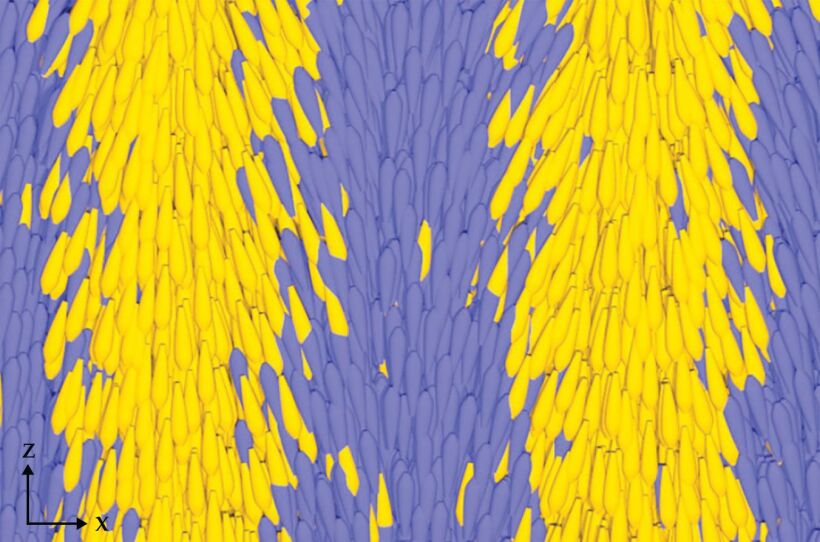
The splay nematic phase in a liquid crystal is made up of polar wedge-shaped molecules. Aligned along the z-axis, the molecules segregate into slightly splayed stripes of molecules with their narrower end pointing toward +z (yellow) and −z (blue). (Adapted from ref.
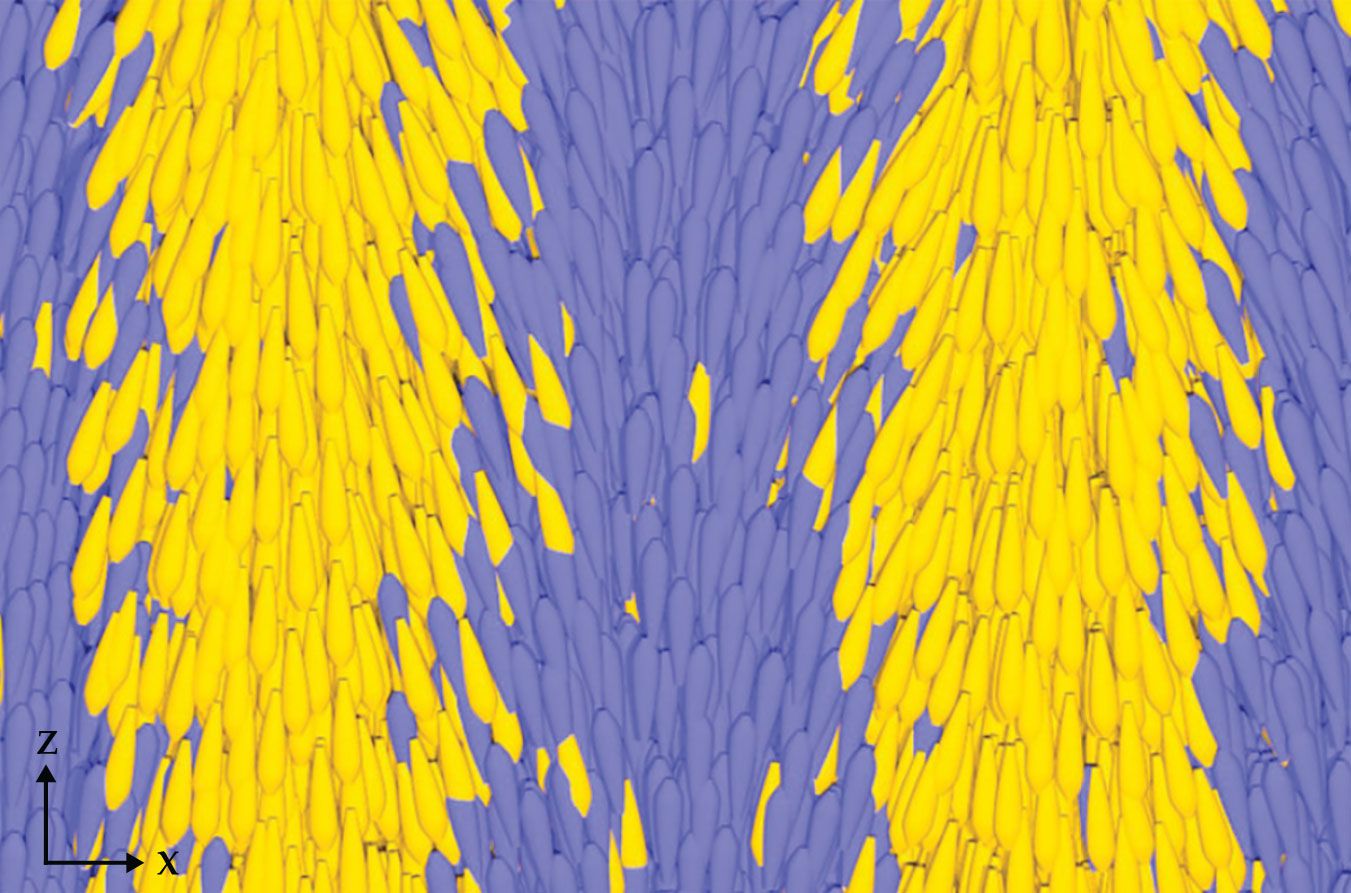
Because the RM734 molecules are slightly wedge shaped—a bit wider at one end than the other—the stripes are also splayed in alternating directions. And they’re surprisingly wide, at several microns, or thousands of times the width of a single molecule.
Long molecules with large electric dipole moments, like RM734, don’t usually seek out such parallel, ferroelectric arrangements in the liquid phase. Rather, they energetically prefer to form antiparallel pairs. So as useful as a ferroelectric liquid might be—its spontaneous polarization could enable molecular orientations to be switched quickly and with low power—ferroelectricity in liquid crystals has until now been limited to smectic phases, which, because of their partial positional order, aren’t fully fluid.
It’s not yet clear exactly what makes RM734 different. The researchers are still working to get a handle on which specific molecular features give rise to the ferroelectric phase, in the hope of being able to tune properties such as the stripe width and the transition temperature. But from what they’ve seen so far, they’ve concluded that a subtle interplay is at work between the molecule’s charge distribution and its shape. Apparently, neither one alone is enough to produce the unusual molecular arrangement, but together they are.
Bend and splay
The polarity–shape interaction is related to the flexoelectric effect, a phenomenon first described in liquid crystals by Robert Meyer half a century ago. 4 Similar to the piezoelectric effect in solids, in which mechanical strain produces an electric potential or vice versa, the flexoelectric effect is the coupling between an electric potential and a strain gradient.
Figure
Figure 2.
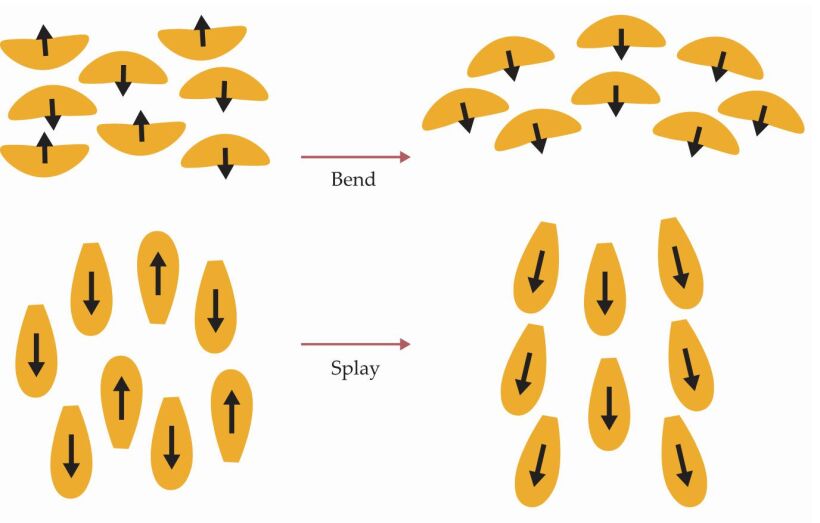
The flexoelectric effect in a nematic liquid crystal describes the coupling between molecular dipoles (black arrows) and strain gradients. Banana-shaped molecules are polarized by an applied bending strain, and wedge-shaped molecules by splay strain. (Courtesy of Nerea Sebastián.)
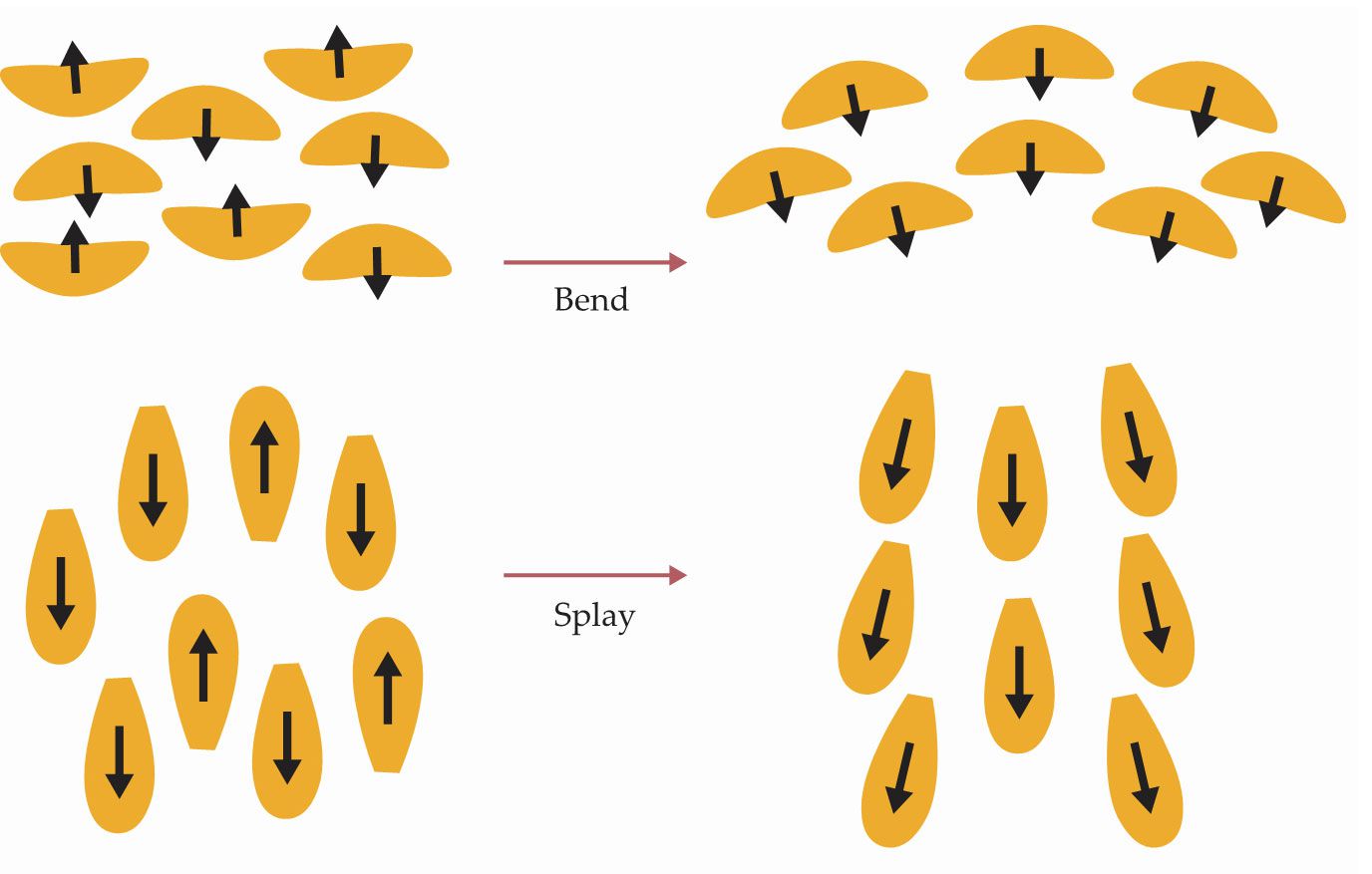
The bottom panel shows a similar reorientation of wedge-shaped molecules with dipoles parallel to their length. This time, the dipoles are aligned by a splay strain gradient: squeezing the liquid crystal at one end and stretching it at the other.
Flexoelectricity is not ferroelectricity; external forces are required to align the dipoles. But in 2001 Ivan Dozov showed theoretically that molecules might align spontaneously under some circumstances, at least over small length scales. 5 Specifically, in a liquid crystal of banana-shaped particles, if the mechanical resistance to bending strain were to somehow go to zero, the molecules would tend toward the bent configuration all by themselves.
However, it’s impossible for a uniformly bent arrangement of curved molecules to fill three-dimensional space: Even in a thin bent layer, the curvature is tighter on the inner surface than the outer one. Dozov proposed that the molecules could overcome that problem by adding a twist—by arranging into loosely wound helical structures that look locally like the bent configuration. Because the helix is turning every few nanometers, there’s no large-scale ferroelectric alignment of molecular dipoles. Still, when the twist–bend nematic phase was experimentally discovered, a decade after Dozov’s prediction, it took the liquid-crystal world by storm. 6 It was the first new kind of nematic phase to be discovered in almost a century.
Wide stripes
Mandle and colleagues weren’t thinking about the flexoelectric effect, or about the twist–bend phase, when they designed RM734. “We were interested in molecules with large electric dipole moments,” explains Mandle. “But our only motivation to make them wedge shaped was to reduce the material’s melting point”—a molecule that’s bulkier at one end than the other would have a harder time organizing into an ordered, solid crystal lattice—“and make it easier to study.” When they saw the unexpected phase transition, though, they were immediately reminded of the twist–bend phase. So was Mertelj, when she heard about the work at a conference and offered to study the unusual liquid crystal in her lab.
The exact relationship to the twist–bend phase, however, was far from clear. “Initially we believed that the second nematic phase was due to the formation of antiparallel pairs of molecules,” says Mertelj, “and unconnected to the material’s mechanical properties.” Later she and her colleagues wondered whether they might be seeing a version of the twist–bend phase itself—but the bend elastic constant showed no unusual behavior at the phase transition. The splay elastic constant, on the other hand, dropped sharply at the transition temperature. “That was a big surprise,” says Mertelj. “We had to remeasure it several times to be certain of what we were seeing.”
Just like the bent arrangement of banana-shaped molecules, though, the splay arrangement of wedge-shaped molecules can’t uniformly fill space. If the RM734 molecules were spontaneously splaying, there had to be something more to the phase structure to compensate. With a little more detective work, the researchers arrived at the modulated structure—the alternating stripes—shown in figure
At first, they supposed that the modulation period, or width of the stripes, would be on the order of nanometers, similar to the pitch of the helices in the twist–bend phase. The splayed phase was optically identical to the ordinary nematic phase, so any structural features seemingly had to be smaller than the wavelength of visible light. And if the phase transition was driven purely by molecular shape, as it seemed to be, the modulations couldn’t be much larger than the dimensions of the molecule itself.
But second harmonic generation (SHG) microscopy told a different story. SHG can occur only in structures that lack inversion symmetry. The interfaces between stripes don’t qualify because they contain about as many molecules pointing one way as the other. But the interior of each stripe, where all molecules point in the same direction, is potentially visible in SHG imaging. “In fact, as we cooled the sample through the phase transition, the signal was so strong that we nearly burned out our detector,” says Mertelj. The SHG image, seen in figure
Figure 3.

The stripe modulations shown in figure
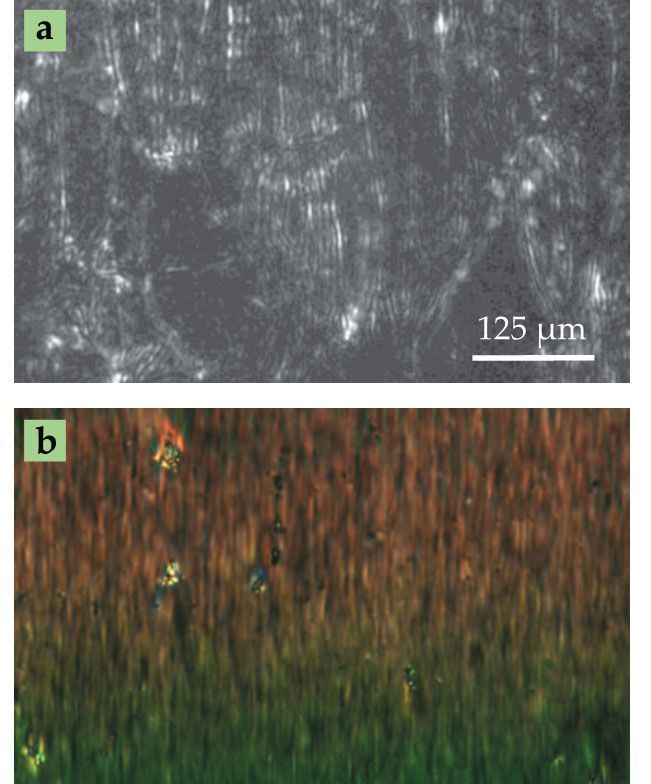
As it turns out, the stripes show up in optical images too, such as the one in figure
Ferroelectric potential
The stripe modulations are too wide to arise from the mechanical effects of molecular shape, but what else could be causing them? If the phase transition was driven by molecular polarity, it would be revealed in the material’s dielectric susceptibility—similar to the critical behavior of the magnetic susceptibility at a ferromagnetic phase transition. But labs equipped for broadband dielectric spectroscopy measurements on liquid crystals are scarce, and Mertelj’s isn’t one of them.
Fortunately, the lab where Sebastián had done her PhD—with María Rosario de la Fuente at the University of the Basque Country in Bilbao, Spain—specializes in just such dielectric measurements. Sebastián took a sample of RM734 back to Bilbao, measured the susceptibility, and found that it diverged at the phase transition. It was a clear signature of ferroelectricity.
From the dielectric measurements and stripe widths, the researchers concluded that the mysterious phase transition is driven primarily by molecular polarity, with shape playing only a bit part. But it must play some role, because most polar liquid-crystal molecules don’t tend toward ferroelectric order. The nature of the polarity–shape interplay is not yet understood.
There’s still a lot of work to do. Experiments so far have focused on the immediate vicinity of the phase transition, and little is known about how RM734 behaves as it’s cooled deeper into the splay nematic phase. Do the stripes, although reoriented, stay more or less the same? Or do more complicated textures form? And how does the behavior change when the molecular features are subtly altered?
An eventual goal is to design a molecule that forms a homogeneous ferroelectric phase: all the molecular dipoles pointing in the same direction, without any splay or stripes. “We strongly believe it is likely that such a material can be found,” says Mertelj. “Everything is possible.”
References
1. R. J. Mandle, S. J. Cowling, J. W. Goodby, Phys. Chem. Chem. Phys. 19, 11429 (2017); https://doi.org/10.1039/C7CP00456G
R. J. Mandle, S. J. Cowling, J. W. Goodby, Chem. Eur. J. 23, 14554 (2017). https://doi.org/10.1002/chem.2017027422. A. Mertelj et al., Phys. Rev. X 8, 041025 (2018). https://doi.org/10.1103/PhysRevX.8.041025
3. N. Sebastián et al., Phys. Rev. Lett. 124, 037801 (2020). https://doi.org/10.1103/PhysRevLett.124.037801
4. R. B. Meyer, Phys. Rev. Lett. 22, 918 (1969). https://doi.org/10.1103/PhysRevLett.22.918
5. I. Dozov, Europhys. Lett. 56, 247 (2001). https://doi.org/10.1209/epl/i2001-00513-x
6. M. Cestari et al., Phys. Rev. E 84, 031704 (2011); https://doi.org/10.1103/PhysRevE.84.031704
K. Adlem et al., Phys. Rev. E 88, 022503 (2013); https://doi.org/10.1103/PhysRevE.88.022503
V. Borshch et al., Nat. Commun. 4, 2635 (2013). https://doi.org/10.1038/ncomms3635
